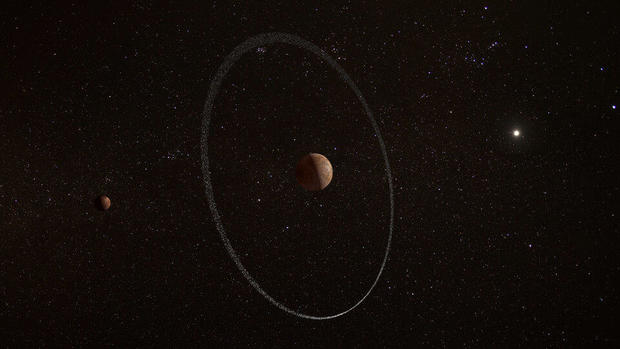Scientists find dense ring around dwarf planet, but can't quite explain why it's there
New telescope data has revealed that a dwarf planet in the outer reaches of the solar system has a dense ring around it, leaving scientists and astronomers confused as to why.
Scientists at the European Space Agency announced Wednesday that data and observations of the planet Quaoar which was collected between 2018 and 2021 —from ground-based telescopes, and the space-based telescope Cheops — led them to the discovery.
The ESA disclosed that Quaoar crossed in front of a succession of distant stars, blocking their light as it passed, in an event called an occultation. When the planet blocked that light, scientists were able to see its ring.
Typically, occultations can be difficult to learn from because the alignment of the planet, stars and telescope has to be perfect, the ESA explained.
"When we put everything together, we saw drops in brightness that were not caused by Quaoar, but that pointed to the presence of material in a circular orbit around it," said Bruno Morgado of the Universidade Federal do Rio de Janeiro in a statement. "The moment we saw that we said, 'Okay, we are seeing a ring around Quaoar.'"
Quaoar is part of a collection of about 3,000 dwarf planets known as trans-Neptunian objects, which are beyond the orbit of the planet Neptune.
Scientists are now wondering why the dense material in Quaoar's ring has not come together to form a small moon, because the ring itself is "at a distance of almost seven and a half times the radius of Quaoar," the ESA said.
While it is rare, Quaoar is not the only dwarf planet to have a ring. Two others, Chariklo and Haumea, have been detected through ground-based observations, according to the ESA. However, the placement of Quaoar's ring makes it more interesting.
Dense ring systems usually exist within what is known as the Roche limit of a planet, the ESA explained. The Roche limit, which exists around a planet or celestial body, is the point at which a celestial object would be broken into many pieces around it. For example, if Earth's moon entered the planet's Roche limit, it would be expected to coalesce into many pieces — perhaps into a ring.
In the case of Quaoar, its dense ring is far out of the Roche limit, leading scientists to wonder why it exists as a ring as opposed to a moon.
"As a result of our observations, the classical notion that dense rings survive only inside the Roche limit of a planetary body must be thoroughly revised," said Giovanni Bruno of Italy's National Institute for Astrophysics.
One early guess as to why Quaoar's dense ring has not formed into a moon is because of the freezing cold temperatures there, the ESA said. The cold could be preventing the icy particles from sticking together.






